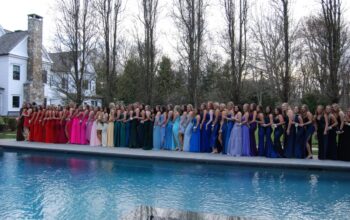Casey Manzella
Features Editor

Photo contributed by Gita Abhiraman
While most students spent their summers relaxing, senior Jack O’Rourke spent five weeks as an intern at Cornell Medical College, sequencing cell lines of Hodgkin’s Lymphoma patients that he aided in the discovery of a mutation in 87% of the patients’ DNA.
“Pending further investigation it could be a hallmark of this cancer, which would be pretty huge in terms of possibly figuring out a treatment for it,” Jack said. “It’s still a long way off, but it could be important.”
Although he did not make this discovery on his own, as an intern he participated in many steps along the way. “One day I might to a qPCR, where I would quantify how much DNA we had,” Jack said. “Somedays we would extract DNA out of a cell-line so that we could sequence it. Somedays we would shear the DNA so that it would be ready to be sequenced.”
This was not Jack’s first experience in a real lab. During the previous two summers Jack interned at the Marine Biological Laboratory in Woods Hole, Massachusetts studying early gene expression and embryonic development of sea anemones. “The summer after my sophomore year was probably the best,” Jack said. “I was micro-injecting the embryos at the one cell stage. We would spawn them overnight and then fertilize them in the morning and then I would inject the zygotes with recombinant Bacterial Artificial Chromosomes, which had a certain gene in it as well as a gene for green fluorescent protein. I would image those cells and compare them with what this lab had previously done with other organisms.”
“I was exposed to a lot in terms of both the research process and biology during the past few summers,” Jack said. “This summer I learned in more detail about Hodgkin’s Lymphoma than I have about anything else just because I would read papers every day and talk to this graduate student who is basically an expert in the field.”
These experiences have lead Jack to pursue more scientific opportunities in the future: next summer and in college. “I’ve definitely been influenced by what I’ve done the past couple of summers because it has been a lot of fun.”
“Ideally, next summer, I could work in a lab where I could actually design my own research project, which I know others have been able to do through other programs, but I haven’t been able to find one.”
Senior Gita Abhiraman was afforded the opportunity to design her own research project. This summer she completed her second year researching Toxoplasma gondii at Albert Einstein College of Medicine. “I had gained a little bit of experience and trust the first year, so I did more of a self-directed project, granted I still got so much assistance and guidance. I had mentors at every step of the way helping me, but I had my own self-guided inquiry,” Gita said.
Toxoplasma gondii is a parasite that causes the disease toxoplasmosis, which although it does not cause symptoms in most people, can be fatal to HIV/AIDs patients or newly pregnant women. “Toxoplasma gondii affects one in three worldwide,” Gita said. “The research I accomplished has medical potential because it can be used to help identify drug targets and possible treatments that can stop the parasite from reproducing or affecting humans.”
Gita decided to spent the past two summers interning in a science lab to fulfill her curiosity about science in the real world. “I’ve always been interested in seeing how science can really be applied,” Gita said. “I think that in the classroom we learn everything in a way that interests me, but doesn’t seem

Photos contributed by Henry Greer
as purposeful as I would like it to so being in the lab helps me see how it directly affects human health or human life. So for me the long term effects, or the bigger vision is what’s more important.”
This summer Gita identified two transcription factors in Toxoplasma gondii, which will potentially help discover drug targets and develop parasite inhibition techniques. This past month Gita submitted these results in a 20-page research paper to the Intel Science Talent Search competition this past month.
With this experiment behind her, Gita hopes to explore new topics next summer including cancer research, Alzheimer’s disease and the effect of music on the brain. “There are never conclusions in science, but I do feel as if I’ve reached a point where I would like to try something new and experiment before I go to college.”
Although Gita is ready to move on, she values her experience from the past two summers. “Being in the lab made me realize that this place where curiosity is encouraged and innovative approaches to finding answers is really valued, is the type of community I could see myself in.”
Senior Henry Greer also spent his summer interning in a lab. He worked at Rockefeller University studying the addictive effects of oxycodone by injecting mice with the drug and then observing their locomotor activity. “The idea is that we want to find a better drug that counteracts the addictive effects of oxycodone to help with withdrawal,” Henry said.
Each day Henry would work from 10 AM to 1PM, 4PM to 6PM and 10PM to 1AM. “On a typical day we would inject the mice with the oxycodone, all 21 of them and then put them in the locomotor activity chambers and run tests on them for 30 minutes,” Henry said. “We have to do that on 3 groups of mice so it would take about an hour and a half, and then we would repeat that.”
When deciding to apply for a science this internship, Henry’s experience in the NCHS science research program was a contributing factor. “I would say my science research class that I took my junior year inspired me,” Henry said. “It opened my eyes to scientific research and made me really keen to find out more about it and try some myself.”
Overall, Henry enjoyed the experience and plans to go back next summer. “It was really interesting and I learned so much about science just in general, and scientific research,” Henry said. “I really got a whole, broad range of skills.”
“With the results from last summer, I’m going to go back next summer and extend it and use what we learned with oxycodone on different drugs, like cocaine and heroine, on the mice,” Henry said.
Like Jack, Henry’s experience working in a lab has influenced his outlook about the future. “This summer made me really interested in neuroscience, biology and neurobiology,” Henry said. “It definitely opened my eyes to the possibility of a career in science and made me far more interested than I ever have been.”



